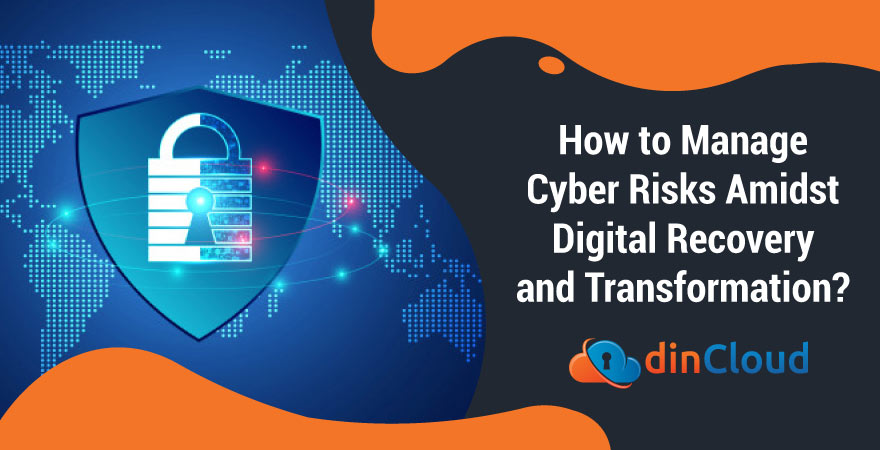The ongoing pandemic has really shaken the business and technology worlds over the past few months. Millions of businesses are scrambling for Business Continuity (BC) Solutions such as cloud computing, but the recovery process is slow and challenging.

A few critical aspects of any such initiative include setting digital recovery priorities, optimal allocation of scarce financial resources and managing the ever-increasing cyber security risks. This post will focus on ways you can manage cyber risks effectively.
Related: dinCloud Beefs Up Its Cyber Security Posture Amidst Covid-19
Covid-19 Pandemic and Cyber Risks
While it may come as a surprise for few, the present IT environment is the most hostile it has ever been in the recent past. Ironically, cyber miscreants across the globe are leveraging the panic induced by this pandemic to launch disruptive cyber-attacks.
Granted that every business is desperate to restore core business operations in some form or the other, cyber security is one area that they can’t afford to overlook. The immediate and long terms costs of any data breach or cyber security incident are too much to ignore.
Related: Cyber Security as a Catalyst for Organizational Growth In 2020
Security Threat Landscape
The present cyber threat landscape comprises of a wide array of launch instruments that include but are not limited to phishing, credential theft, ransomware, distributed denial of service (DDoS) attacks and much more.
Each of these threats poses a unique set of security challenges for business enterprises that are already racing against time to get themselves up and running. Regardless of the urgency, cyber security is an issue over which there simply can’t be any compromise.
Related: Spending on Cloud Infrastructure Grows by 37% in Q1 of 2020
How to Manage Your Cyber Risks?
Below are a few important strategies you should consider implementing if you are going through a digital recovery or otherwise transforming organizational IT architecture.
Modular Approach to Security
At the top most strategic level of organizations, digital initiatives may take a lot of time to get past the typical bureaucratic hurdles. To add to all this, there is the additional element of a natural resistance to change from within the digitally realigning entity.
The urgent nature of preparing for and responding to present age cyber threats demands that the approval mechanism for such initiatives be realigned altogether. This will require empowering cyber security experts to take such decisions without lengthy approvals.
Further, a certain cyber security strategy can be further divided into smaller chunks or modules. This will not only enhance the understanding of such initiatives for non IT personnel, but also expedite the resource allocation process due to simplicity.
Related: Jan 2020 Roundup of Data and Cyber Security Breaches
Incorporate Security in IT Architecture
Gone are the days when you could approach cyber security as an individual aspect of operations. It won’t be wrong to say that in the present scenario, it is the security related priorities around which the whole IT architecture should be built.
Failing to adopt this approach and trying to rush up any digital recovery initiative can have potentially devastating consequences over the mid to long term. In the present scenario, this approach can also give rise to many disruptive compliance issues.
Related: The Challenges of Securing Cloud Powered Healthcare
Transform Elevated IT Access Rights
While giving certain users of your IT infrastructure elevated rights or privileges is simply unavoidable, it is imperative that the approach be changed. Instead of windfall user privileges, this domain has to be narrowed down to each functional area.
Even this approach alone may prove insufficient under the present hostile cyber landscape. You should further complement this approach with identity management, access control systems and a multi factor user authentication mechanism to name a few.
Related: How Cloud Service Providers Enhance Cyber Resilience?
Implement Across the Board Controls
Now, the approach of granting a few IT professionals unchecked user privileges has to come to an end. Instead, what’s required is the implementation of cyber security controls across the board, with no exceptions whatsoever. This can leave huge gaps in security.
Any such rights or privileges should further be highly restricted to the professional’s functional areas. By doing so, you will be reducing the attack surface that may potentially be exposed to a cyber threat that has even gone past the implemented controls.
Related: 17 Best Practices to Attain Secure Remote Work Environments
Constant Evaluation and Realignment
Last but not the least, you constantly need to evaluate or benchmark your existing cyber security apparatus with the latest cyber threats. As soon as a vulnerability is identified, whether it affected your entity or some other, it needs immediate attention.
Conclusion
These were just some strategies that can potentially reduce the huge present day challenge of cyber security. In case you are struggling with securing your on premise IT architecture, you can try dinCloud’s Industry Leading Cloud Solutions.
dinCloud’s Hosted Virtual Solutions will take care of the otherwise difficult to navigate area of cyber security. Our state of the art global data centers are secured with some of the world’s best cyber security solutions, so you can relax and focus on core business areas.


